Public Health Policy II: Analysis of Food Labeling Regulations
VerifiedAdded on 2023/06/05
|9
|2117
|79
Report
AI Summary
This report provides an analysis of a proposed public health policy concerning the regulation of sugar labeling on packaged foods and drinks. It addresses key public health considerations, including dietary guidelines, nutrition, food safety, and contamination. The report discusses the strengths and weaknesses of the draft policy, such as its potential to increase consumer understanding through education campaigns versus its limited time frame and potential expense. It also recommends improvements such as limiting sugary food consumption, providing physical activity guidelines, and ensuring manufacturers offer comprehensive information on added sugars. The report emphasizes the importance of food labeling as a communication tool between manufacturers and consumers, enabling informed choices and supporting dietary guidelines. The author recommends that policymakers consider regulations that can be used to establish viable dietary guidelines.
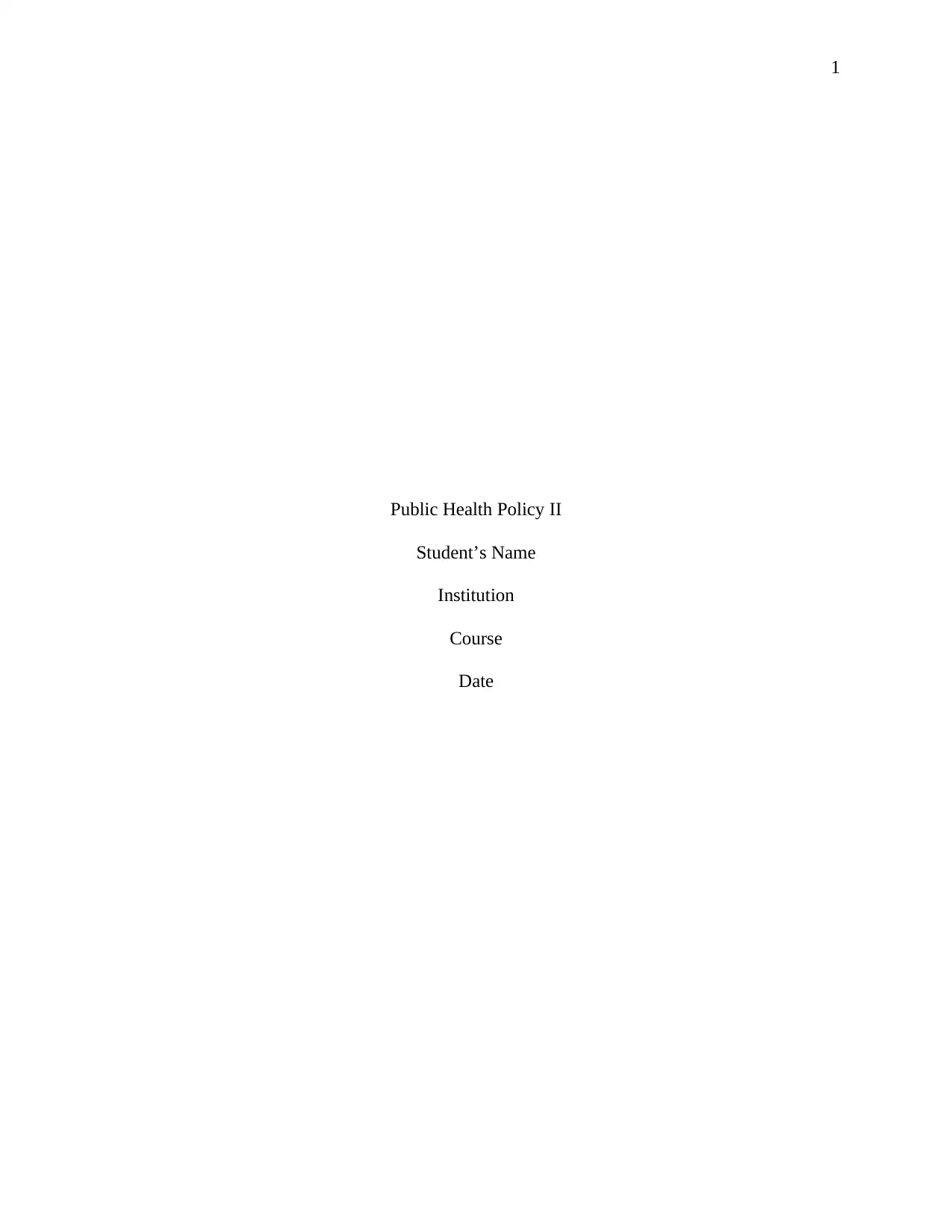
1
Public Health Policy II
Student’s Name
Institution
Course
Date
Public Health Policy II
Student’s Name
Institution
Course
Date
Paraphrase This Document
Need a fresh take? Get an instant paraphrase of this document with our AI Paraphraser
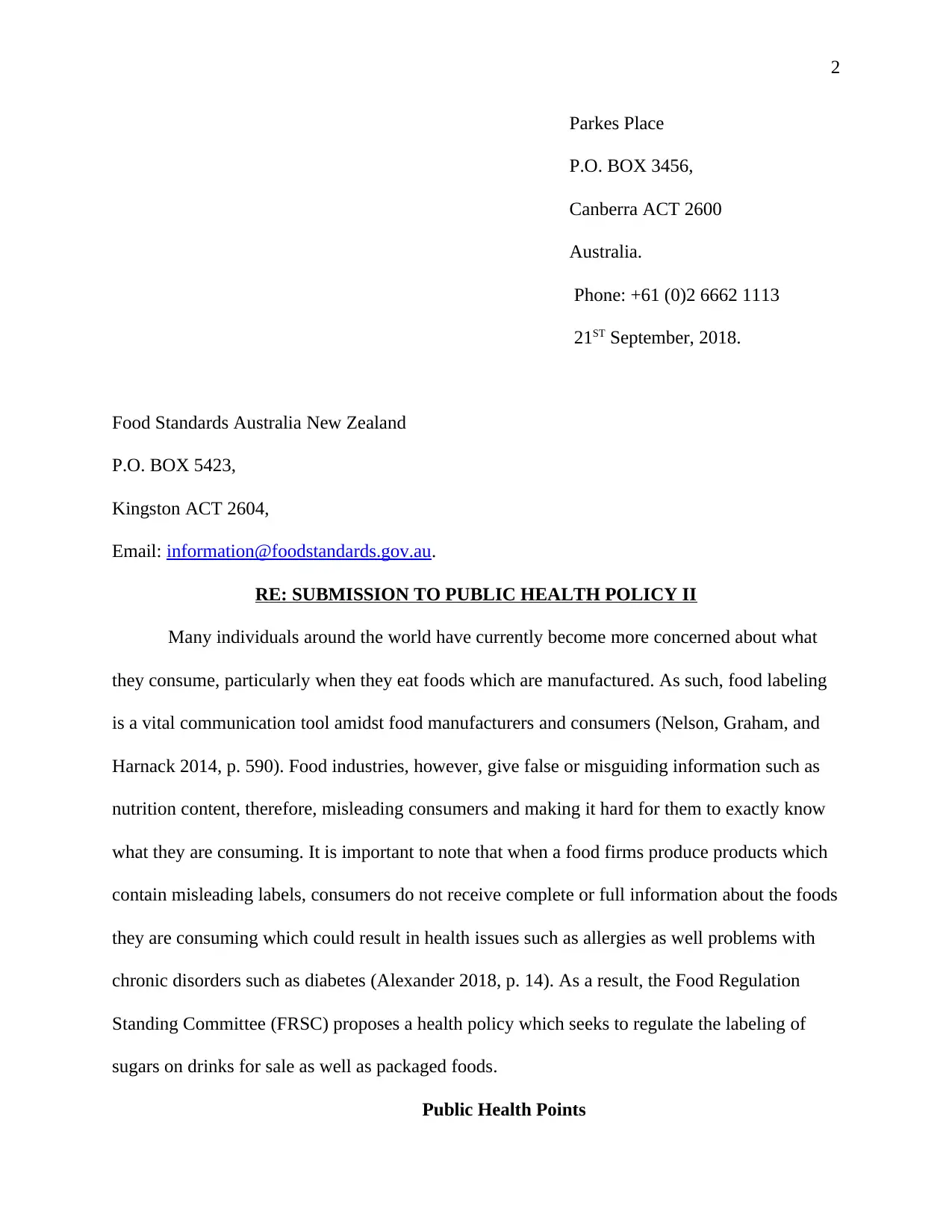
2
Parkes Place
P.O. BOX 3456,
Canberra ACT 2600
Australia.
Phone: +61 (0)2 6662 1113
21ST September, 2018.
Food Standards Australia New Zealand
P.O. BOX 5423,
Kingston ACT 2604,
Email: information@foodstandards.gov.au.
RE: SUBMISSION TO PUBLIC HEALTH POLICY II
Many individuals around the world have currently become more concerned about what
they consume, particularly when they eat foods which are manufactured. As such, food labeling
is a vital communication tool amidst food manufacturers and consumers (Nelson, Graham, and
Harnack 2014, p. 590). Food industries, however, give false or misguiding information such as
nutrition content, therefore, misleading consumers and making it hard for them to exactly know
what they are consuming. It is important to note that when a food firms produce products which
contain misleading labels, consumers do not receive complete or full information about the foods
they are consuming which could result in health issues such as allergies as well problems with
chronic disorders such as diabetes (Alexander 2018, p. 14). As a result, the Food Regulation
Standing Committee (FRSC) proposes a health policy which seeks to regulate the labeling of
sugars on drinks for sale as well as packaged foods.
Public Health Points
Parkes Place
P.O. BOX 3456,
Canberra ACT 2600
Australia.
Phone: +61 (0)2 6662 1113
21ST September, 2018.
Food Standards Australia New Zealand
P.O. BOX 5423,
Kingston ACT 2604,
Email: information@foodstandards.gov.au.
RE: SUBMISSION TO PUBLIC HEALTH POLICY II
Many individuals around the world have currently become more concerned about what
they consume, particularly when they eat foods which are manufactured. As such, food labeling
is a vital communication tool amidst food manufacturers and consumers (Nelson, Graham, and
Harnack 2014, p. 590). Food industries, however, give false or misguiding information such as
nutrition content, therefore, misleading consumers and making it hard for them to exactly know
what they are consuming. It is important to note that when a food firms produce products which
contain misleading labels, consumers do not receive complete or full information about the foods
they are consuming which could result in health issues such as allergies as well problems with
chronic disorders such as diabetes (Alexander 2018, p. 14). As a result, the Food Regulation
Standing Committee (FRSC) proposes a health policy which seeks to regulate the labeling of
sugars on drinks for sale as well as packaged foods.
Public Health Points
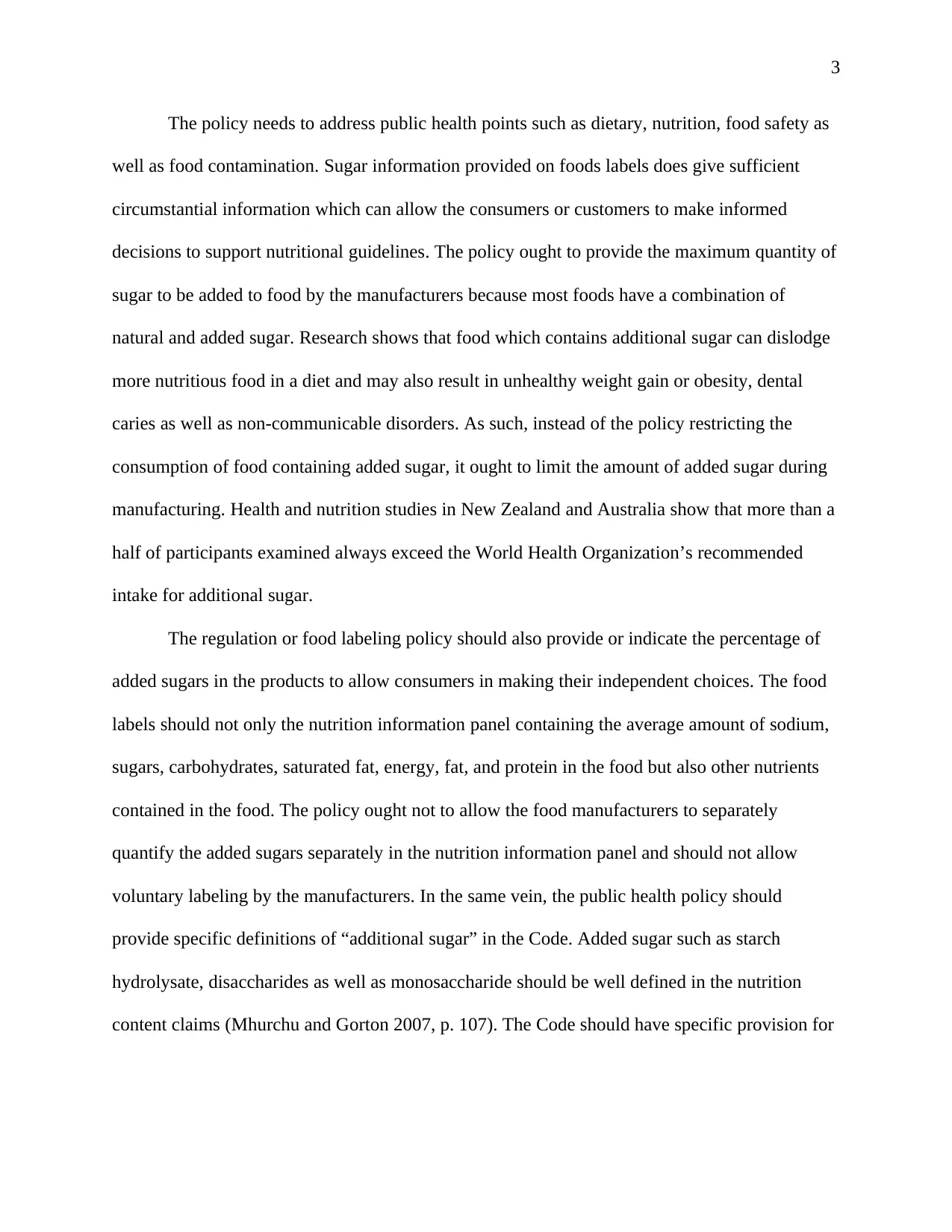
3
The policy needs to address public health points such as dietary, nutrition, food safety as
well as food contamination. Sugar information provided on foods labels does give sufficient
circumstantial information which can allow the consumers or customers to make informed
decisions to support nutritional guidelines. The policy ought to provide the maximum quantity of
sugar to be added to food by the manufacturers because most foods have a combination of
natural and added sugar. Research shows that food which contains additional sugar can dislodge
more nutritious food in a diet and may also result in unhealthy weight gain or obesity, dental
caries as well as non-communicable disorders. As such, instead of the policy restricting the
consumption of food containing added sugar, it ought to limit the amount of added sugar during
manufacturing. Health and nutrition studies in New Zealand and Australia show that more than a
half of participants examined always exceed the World Health Organization’s recommended
intake for additional sugar.
The regulation or food labeling policy should also provide or indicate the percentage of
added sugars in the products to allow consumers in making their independent choices. The food
labels should not only the nutrition information panel containing the average amount of sodium,
sugars, carbohydrates, saturated fat, energy, fat, and protein in the food but also other nutrients
contained in the food. The policy ought not to allow the food manufacturers to separately
quantify the added sugars separately in the nutrition information panel and should not allow
voluntary labeling by the manufacturers. In the same vein, the public health policy should
provide specific definitions of “additional sugar” in the Code. Added sugar such as starch
hydrolysate, disaccharides as well as monosaccharide should be well defined in the nutrition
content claims (Mhurchu and Gorton 2007, p. 107). The Code should have specific provision for
The policy needs to address public health points such as dietary, nutrition, food safety as
well as food contamination. Sugar information provided on foods labels does give sufficient
circumstantial information which can allow the consumers or customers to make informed
decisions to support nutritional guidelines. The policy ought to provide the maximum quantity of
sugar to be added to food by the manufacturers because most foods have a combination of
natural and added sugar. Research shows that food which contains additional sugar can dislodge
more nutritious food in a diet and may also result in unhealthy weight gain or obesity, dental
caries as well as non-communicable disorders. As such, instead of the policy restricting the
consumption of food containing added sugar, it ought to limit the amount of added sugar during
manufacturing. Health and nutrition studies in New Zealand and Australia show that more than a
half of participants examined always exceed the World Health Organization’s recommended
intake for additional sugar.
The regulation or food labeling policy should also provide or indicate the percentage of
added sugars in the products to allow consumers in making their independent choices. The food
labels should not only the nutrition information panel containing the average amount of sodium,
sugars, carbohydrates, saturated fat, energy, fat, and protein in the food but also other nutrients
contained in the food. The policy ought not to allow the food manufacturers to separately
quantify the added sugars separately in the nutrition information panel and should not allow
voluntary labeling by the manufacturers. In the same vein, the public health policy should
provide specific definitions of “additional sugar” in the Code. Added sugar such as starch
hydrolysate, disaccharides as well as monosaccharide should be well defined in the nutrition
content claims (Mhurchu and Gorton 2007, p. 107). The Code should have specific provision for
⊘ This is a preview!⊘
Do you want full access?
Subscribe today to unlock all pages.

Trusted by 1+ million students worldwide
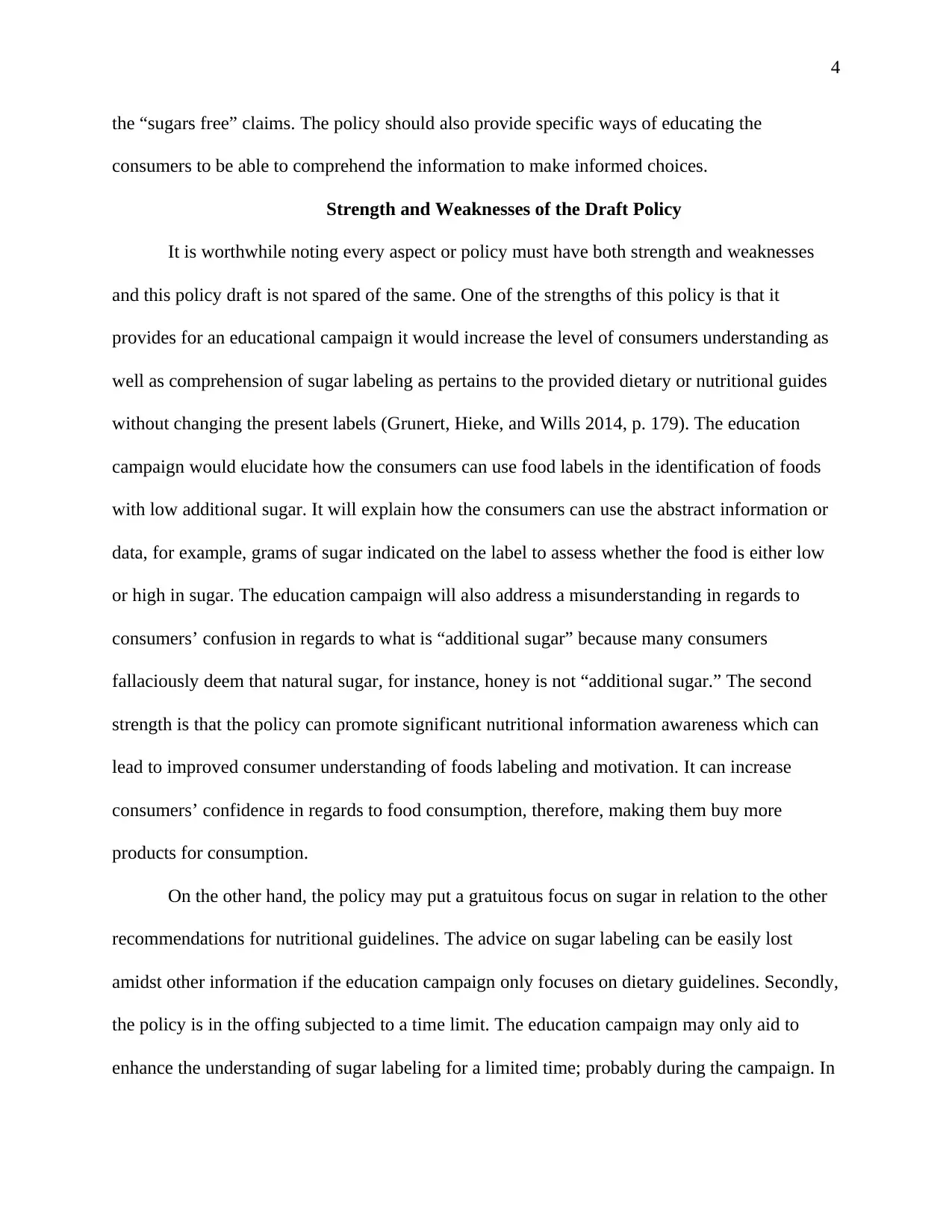
4
the “sugars free” claims. The policy should also provide specific ways of educating the
consumers to be able to comprehend the information to make informed choices.
Strength and Weaknesses of the Draft Policy
It is worthwhile noting every aspect or policy must have both strength and weaknesses
and this policy draft is not spared of the same. One of the strengths of this policy is that it
provides for an educational campaign it would increase the level of consumers understanding as
well as comprehension of sugar labeling as pertains to the provided dietary or nutritional guides
without changing the present labels (Grunert, Hieke, and Wills 2014, p. 179). The education
campaign would elucidate how the consumers can use food labels in the identification of foods
with low additional sugar. It will explain how the consumers can use the abstract information or
data, for example, grams of sugar indicated on the label to assess whether the food is either low
or high in sugar. The education campaign will also address a misunderstanding in regards to
consumers’ confusion in regards to what is “additional sugar” because many consumers
fallaciously deem that natural sugar, for instance, honey is not “additional sugar.” The second
strength is that the policy can promote significant nutritional information awareness which can
lead to improved consumer understanding of foods labeling and motivation. It can increase
consumers’ confidence in regards to food consumption, therefore, making them buy more
products for consumption.
On the other hand, the policy may put a gratuitous focus on sugar in relation to the other
recommendations for nutritional guidelines. The advice on sugar labeling can be easily lost
amidst other information if the education campaign only focuses on dietary guidelines. Secondly,
the policy is in the offing subjected to a time limit. The education campaign may only aid to
enhance the understanding of sugar labeling for a limited time; probably during the campaign. In
the “sugars free” claims. The policy should also provide specific ways of educating the
consumers to be able to comprehend the information to make informed choices.
Strength and Weaknesses of the Draft Policy
It is worthwhile noting every aspect or policy must have both strength and weaknesses
and this policy draft is not spared of the same. One of the strengths of this policy is that it
provides for an educational campaign it would increase the level of consumers understanding as
well as comprehension of sugar labeling as pertains to the provided dietary or nutritional guides
without changing the present labels (Grunert, Hieke, and Wills 2014, p. 179). The education
campaign would elucidate how the consumers can use food labels in the identification of foods
with low additional sugar. It will explain how the consumers can use the abstract information or
data, for example, grams of sugar indicated on the label to assess whether the food is either low
or high in sugar. The education campaign will also address a misunderstanding in regards to
consumers’ confusion in regards to what is “additional sugar” because many consumers
fallaciously deem that natural sugar, for instance, honey is not “additional sugar.” The second
strength is that the policy can promote significant nutritional information awareness which can
lead to improved consumer understanding of foods labeling and motivation. It can increase
consumers’ confidence in regards to food consumption, therefore, making them buy more
products for consumption.
On the other hand, the policy may put a gratuitous focus on sugar in relation to the other
recommendations for nutritional guidelines. The advice on sugar labeling can be easily lost
amidst other information if the education campaign only focuses on dietary guidelines. Secondly,
the policy is in the offing subjected to a time limit. The education campaign may only aid to
enhance the understanding of sugar labeling for a limited time; probably during the campaign. In
Paraphrase This Document
Need a fresh take? Get an instant paraphrase of this document with our AI Paraphraser
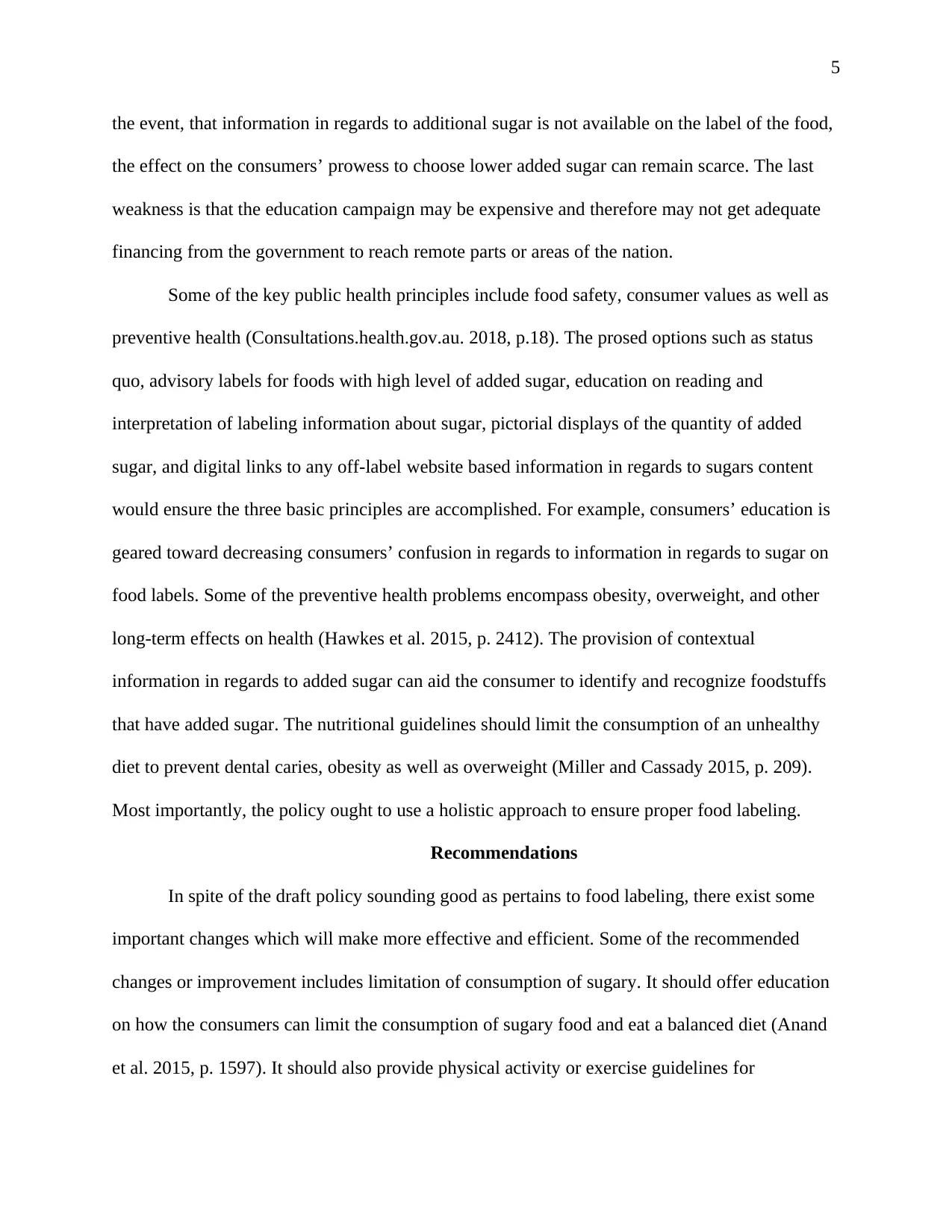
5
the event, that information in regards to additional sugar is not available on the label of the food,
the effect on the consumers’ prowess to choose lower added sugar can remain scarce. The last
weakness is that the education campaign may be expensive and therefore may not get adequate
financing from the government to reach remote parts or areas of the nation.
Some of the key public health principles include food safety, consumer values as well as
preventive health (Consultations.health.gov.au. 2018, p.18). The prosed options such as status
quo, advisory labels for foods with high level of added sugar, education on reading and
interpretation of labeling information about sugar, pictorial displays of the quantity of added
sugar, and digital links to any off-label website based information in regards to sugars content
would ensure the three basic principles are accomplished. For example, consumers’ education is
geared toward decreasing consumers’ confusion in regards to information in regards to sugar on
food labels. Some of the preventive health problems encompass obesity, overweight, and other
long-term effects on health (Hawkes et al. 2015, p. 2412). The provision of contextual
information in regards to added sugar can aid the consumer to identify and recognize foodstuffs
that have added sugar. The nutritional guidelines should limit the consumption of an unhealthy
diet to prevent dental caries, obesity as well as overweight (Miller and Cassady 2015, p. 209).
Most importantly, the policy ought to use a holistic approach to ensure proper food labeling.
Recommendations
In spite of the draft policy sounding good as pertains to food labeling, there exist some
important changes which will make more effective and efficient. Some of the recommended
changes or improvement includes limitation of consumption of sugary. It should offer education
on how the consumers can limit the consumption of sugary food and eat a balanced diet (Anand
et al. 2015, p. 1597). It should also provide physical activity or exercise guidelines for
the event, that information in regards to additional sugar is not available on the label of the food,
the effect on the consumers’ prowess to choose lower added sugar can remain scarce. The last
weakness is that the education campaign may be expensive and therefore may not get adequate
financing from the government to reach remote parts or areas of the nation.
Some of the key public health principles include food safety, consumer values as well as
preventive health (Consultations.health.gov.au. 2018, p.18). The prosed options such as status
quo, advisory labels for foods with high level of added sugar, education on reading and
interpretation of labeling information about sugar, pictorial displays of the quantity of added
sugar, and digital links to any off-label website based information in regards to sugars content
would ensure the three basic principles are accomplished. For example, consumers’ education is
geared toward decreasing consumers’ confusion in regards to information in regards to sugar on
food labels. Some of the preventive health problems encompass obesity, overweight, and other
long-term effects on health (Hawkes et al. 2015, p. 2412). The provision of contextual
information in regards to added sugar can aid the consumer to identify and recognize foodstuffs
that have added sugar. The nutritional guidelines should limit the consumption of an unhealthy
diet to prevent dental caries, obesity as well as overweight (Miller and Cassady 2015, p. 209).
Most importantly, the policy ought to use a holistic approach to ensure proper food labeling.
Recommendations
In spite of the draft policy sounding good as pertains to food labeling, there exist some
important changes which will make more effective and efficient. Some of the recommended
changes or improvement includes limitation of consumption of sugary. It should offer education
on how the consumers can limit the consumption of sugary food and eat a balanced diet (Anand
et al. 2015, p. 1597). It should also provide physical activity or exercise guidelines for
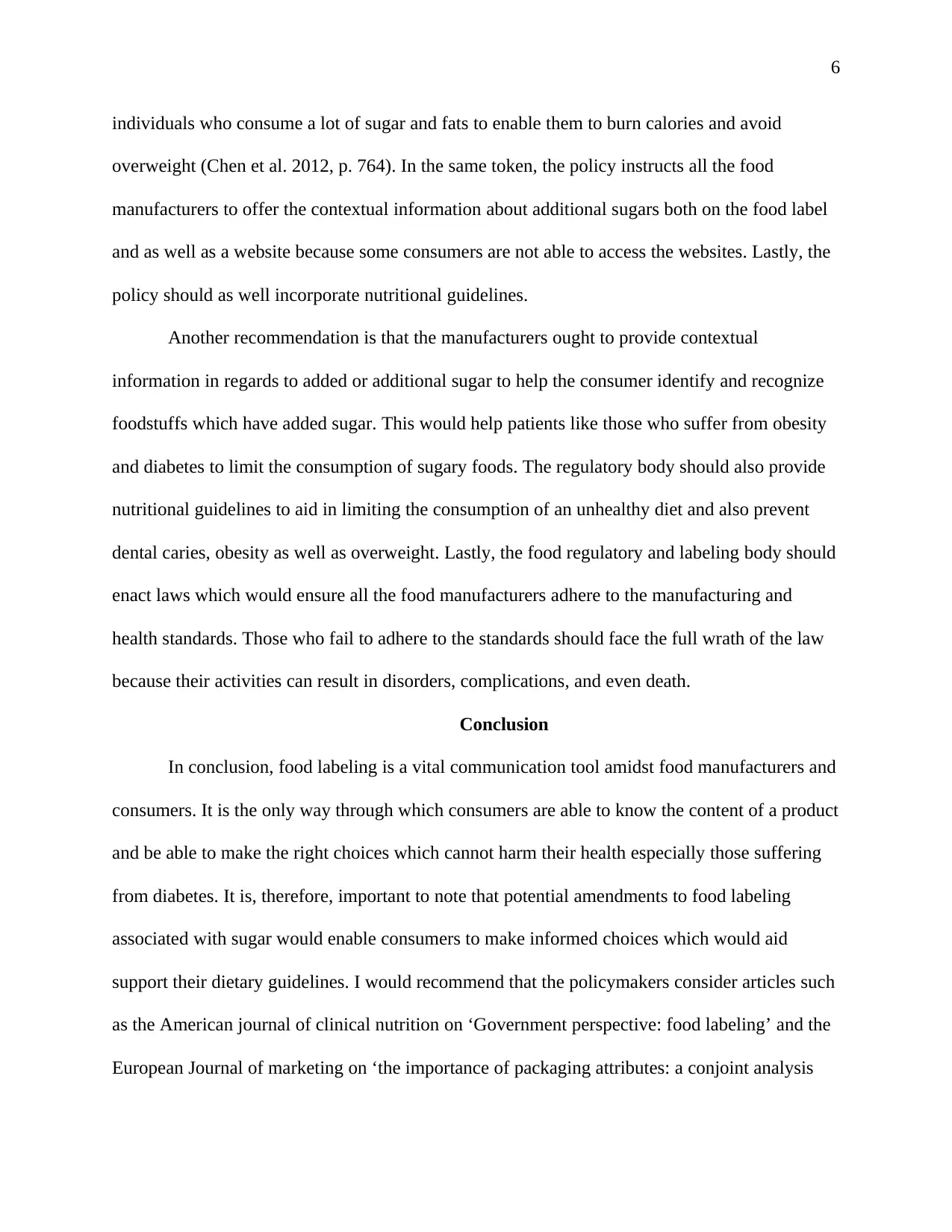
6
individuals who consume a lot of sugar and fats to enable them to burn calories and avoid
overweight (Chen et al. 2012, p. 764). In the same token, the policy instructs all the food
manufacturers to offer the contextual information about additional sugars both on the food label
and as well as a website because some consumers are not able to access the websites. Lastly, the
policy should as well incorporate nutritional guidelines.
Another recommendation is that the manufacturers ought to provide contextual
information in regards to added or additional sugar to help the consumer identify and recognize
foodstuffs which have added sugar. This would help patients like those who suffer from obesity
and diabetes to limit the consumption of sugary foods. The regulatory body should also provide
nutritional guidelines to aid in limiting the consumption of an unhealthy diet and also prevent
dental caries, obesity as well as overweight. Lastly, the food regulatory and labeling body should
enact laws which would ensure all the food manufacturers adhere to the manufacturing and
health standards. Those who fail to adhere to the standards should face the full wrath of the law
because their activities can result in disorders, complications, and even death.
Conclusion
In conclusion, food labeling is a vital communication tool amidst food manufacturers and
consumers. It is the only way through which consumers are able to know the content of a product
and be able to make the right choices which cannot harm their health especially those suffering
from diabetes. It is, therefore, important to note that potential amendments to food labeling
associated with sugar would enable consumers to make informed choices which would aid
support their dietary guidelines. I would recommend that the policymakers consider articles such
as the American journal of clinical nutrition on ‘Government perspective: food labeling’ and the
European Journal of marketing on ‘the importance of packaging attributes: a conjoint analysis
individuals who consume a lot of sugar and fats to enable them to burn calories and avoid
overweight (Chen et al. 2012, p. 764). In the same token, the policy instructs all the food
manufacturers to offer the contextual information about additional sugars both on the food label
and as well as a website because some consumers are not able to access the websites. Lastly, the
policy should as well incorporate nutritional guidelines.
Another recommendation is that the manufacturers ought to provide contextual
information in regards to added or additional sugar to help the consumer identify and recognize
foodstuffs which have added sugar. This would help patients like those who suffer from obesity
and diabetes to limit the consumption of sugary foods. The regulatory body should also provide
nutritional guidelines to aid in limiting the consumption of an unhealthy diet and also prevent
dental caries, obesity as well as overweight. Lastly, the food regulatory and labeling body should
enact laws which would ensure all the food manufacturers adhere to the manufacturing and
health standards. Those who fail to adhere to the standards should face the full wrath of the law
because their activities can result in disorders, complications, and even death.
Conclusion
In conclusion, food labeling is a vital communication tool amidst food manufacturers and
consumers. It is the only way through which consumers are able to know the content of a product
and be able to make the right choices which cannot harm their health especially those suffering
from diabetes. It is, therefore, important to note that potential amendments to food labeling
associated with sugar would enable consumers to make informed choices which would aid
support their dietary guidelines. I would recommend that the policymakers consider articles such
as the American journal of clinical nutrition on ‘Government perspective: food labeling’ and the
European Journal of marketing on ‘the importance of packaging attributes: a conjoint analysis
⊘ This is a preview!⊘
Do you want full access?
Subscribe today to unlock all pages.

Trusted by 1+ million students worldwide
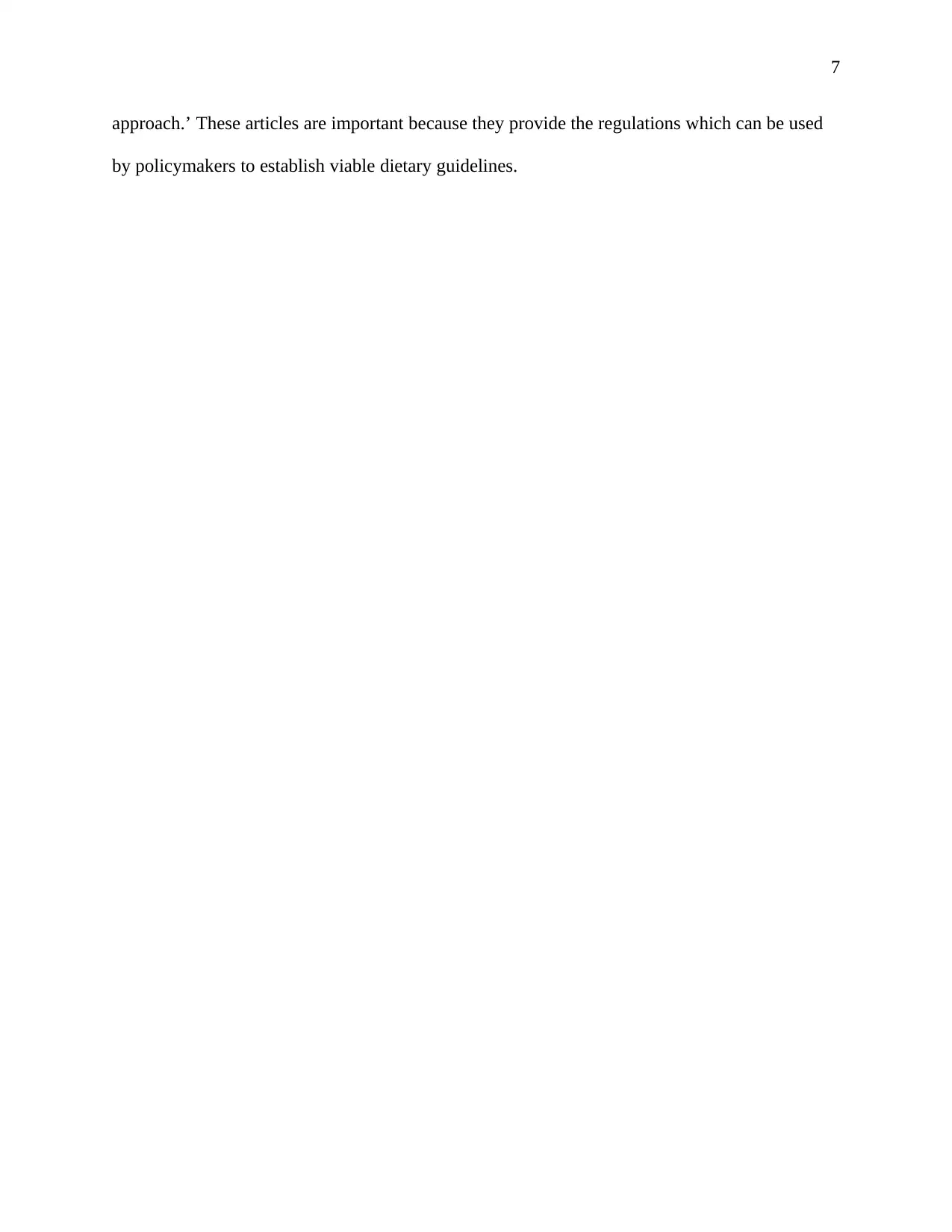
7
approach.’ These articles are important because they provide the regulations which can be used
by policymakers to establish viable dietary guidelines.
approach.’ These articles are important because they provide the regulations which can be used
by policymakers to establish viable dietary guidelines.
Paraphrase This Document
Need a fresh take? Get an instant paraphrase of this document with our AI Paraphraser
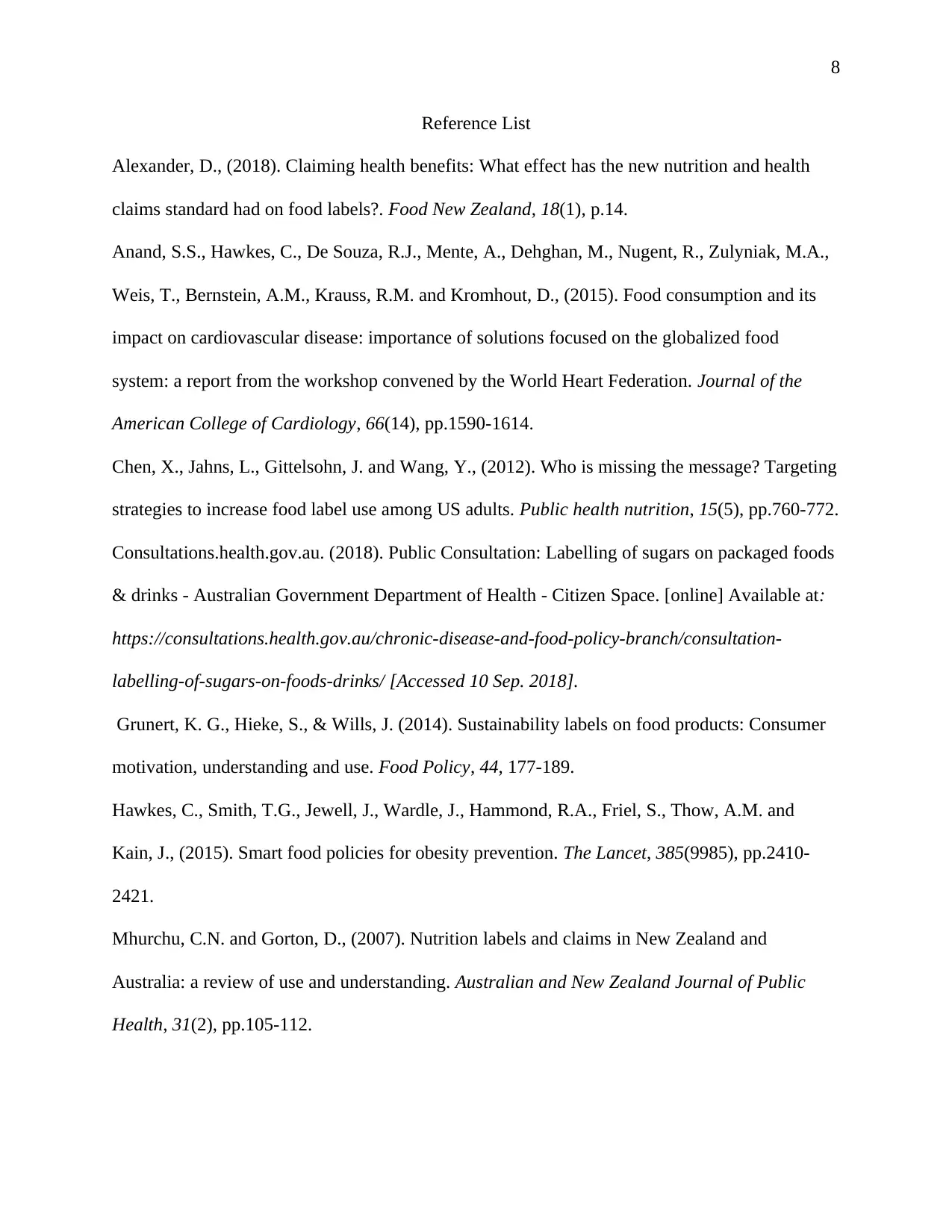
8
Reference List
Alexander, D., (2018). Claiming health benefits: What effect has the new nutrition and health
claims standard had on food labels?. Food New Zealand, 18(1), p.14.
Anand, S.S., Hawkes, C., De Souza, R.J., Mente, A., Dehghan, M., Nugent, R., Zulyniak, M.A.,
Weis, T., Bernstein, A.M., Krauss, R.M. and Kromhout, D., (2015). Food consumption and its
impact on cardiovascular disease: importance of solutions focused on the globalized food
system: a report from the workshop convened by the World Heart Federation. Journal of the
American College of Cardiology, 66(14), pp.1590-1614.
Chen, X., Jahns, L., Gittelsohn, J. and Wang, Y., (2012). Who is missing the message? Targeting
strategies to increase food label use among US adults. Public health nutrition, 15(5), pp.760-772.
Consultations.health.gov.au. (2018). Public Consultation: Labelling of sugars on packaged foods
& drinks - Australian Government Department of Health - Citizen Space. [online] Available at:
https://consultations.health.gov.au/chronic-disease-and-food-policy-branch/consultation-
labelling-of-sugars-on-foods-drinks/ [Accessed 10 Sep. 2018].
Grunert, K. G., Hieke, S., & Wills, J. (2014). Sustainability labels on food products: Consumer
motivation, understanding and use. Food Policy, 44, 177-189.
Hawkes, C., Smith, T.G., Jewell, J., Wardle, J., Hammond, R.A., Friel, S., Thow, A.M. and
Kain, J., (2015). Smart food policies for obesity prevention. The Lancet, 385(9985), pp.2410-
2421.
Mhurchu, C.N. and Gorton, D., (2007). Nutrition labels and claims in New Zealand and
Australia: a review of use and understanding. Australian and New Zealand Journal of Public
Health, 31(2), pp.105-112.
Reference List
Alexander, D., (2018). Claiming health benefits: What effect has the new nutrition and health
claims standard had on food labels?. Food New Zealand, 18(1), p.14.
Anand, S.S., Hawkes, C., De Souza, R.J., Mente, A., Dehghan, M., Nugent, R., Zulyniak, M.A.,
Weis, T., Bernstein, A.M., Krauss, R.M. and Kromhout, D., (2015). Food consumption and its
impact on cardiovascular disease: importance of solutions focused on the globalized food
system: a report from the workshop convened by the World Heart Federation. Journal of the
American College of Cardiology, 66(14), pp.1590-1614.
Chen, X., Jahns, L., Gittelsohn, J. and Wang, Y., (2012). Who is missing the message? Targeting
strategies to increase food label use among US adults. Public health nutrition, 15(5), pp.760-772.
Consultations.health.gov.au. (2018). Public Consultation: Labelling of sugars on packaged foods
& drinks - Australian Government Department of Health - Citizen Space. [online] Available at:
https://consultations.health.gov.au/chronic-disease-and-food-policy-branch/consultation-
labelling-of-sugars-on-foods-drinks/ [Accessed 10 Sep. 2018].
Grunert, K. G., Hieke, S., & Wills, J. (2014). Sustainability labels on food products: Consumer
motivation, understanding and use. Food Policy, 44, 177-189.
Hawkes, C., Smith, T.G., Jewell, J., Wardle, J., Hammond, R.A., Friel, S., Thow, A.M. and
Kain, J., (2015). Smart food policies for obesity prevention. The Lancet, 385(9985), pp.2410-
2421.
Mhurchu, C.N. and Gorton, D., (2007). Nutrition labels and claims in New Zealand and
Australia: a review of use and understanding. Australian and New Zealand Journal of Public
Health, 31(2), pp.105-112.
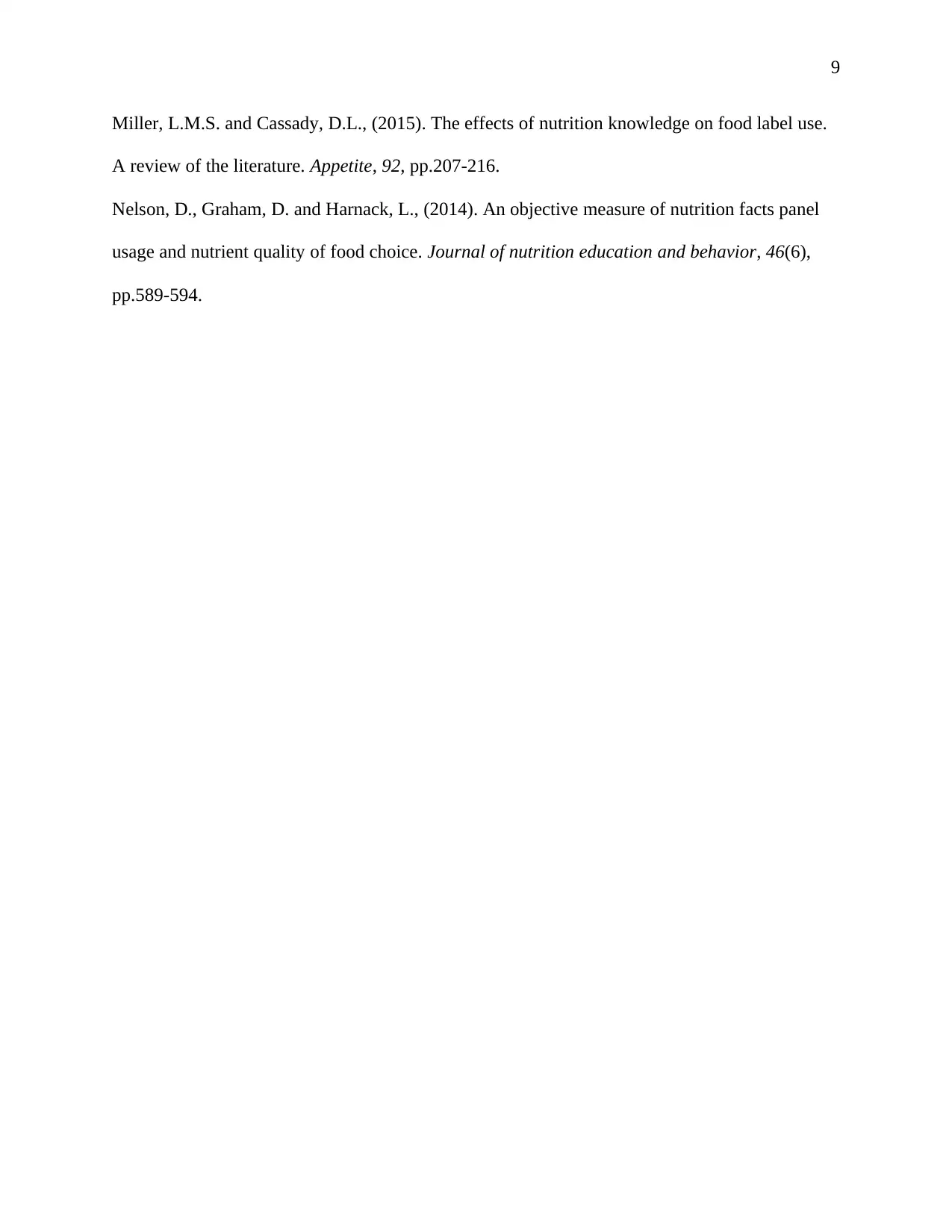
9
Miller, L.M.S. and Cassady, D.L., (2015). The effects of nutrition knowledge on food label use.
A review of the literature. Appetite, 92, pp.207-216.
Nelson, D., Graham, D. and Harnack, L., (2014). An objective measure of nutrition facts panel
usage and nutrient quality of food choice. Journal of nutrition education and behavior, 46(6),
pp.589-594.
Miller, L.M.S. and Cassady, D.L., (2015). The effects of nutrition knowledge on food label use.
A review of the literature. Appetite, 92, pp.207-216.
Nelson, D., Graham, D. and Harnack, L., (2014). An objective measure of nutrition facts panel
usage and nutrient quality of food choice. Journal of nutrition education and behavior, 46(6),
pp.589-594.
⊘ This is a preview!⊘
Do you want full access?
Subscribe today to unlock all pages.

Trusted by 1+ million students worldwide
1 out of 9
Related Documents
Your All-in-One AI-Powered Toolkit for Academic Success.
+13062052269
info@desklib.com
Available 24*7 on WhatsApp / Email
![[object Object]](/_next/static/media/star-bottom.7253800d.svg)
Unlock your academic potential
Copyright © 2020–2025 A2Z Services. All Rights Reserved. Developed and managed by ZUCOL.



